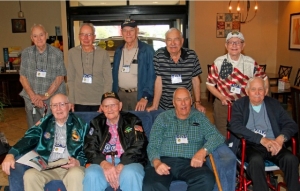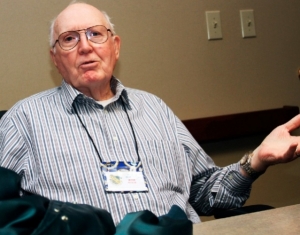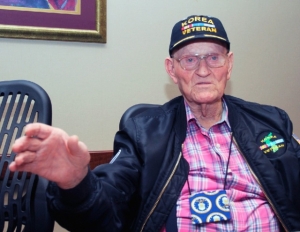The Korean War: Veterans recall their roles with the 4th Fighter Interceptor Wing
By Steve Herring
Published in News on October 29, 2017 8:37 PM

News-Argus/STEVE HERRING
Members of the 4th Fighter Interceptor Wing Association held a reunion this past week at Seymour Johnson Air Force Base. Front row from left: Jesse Black, Max Garland, Ronald Spengler and Andrew Whipple. Standing from left: Russ Gray, Anthony Sepienza, Bob Kroupa, Carlo Romano and Richard Schneider.

News-Argus/STEVE HERRING
"He'd drop hand grenades on us as he got over the base. You never knew where he was going to hit, but he never did much damage really. He just kept us awake when we needed to sleep." ---- Jess Black, Kimpo Air Base, 1951-52

News-Argus/STEVE HERRING
"I get down there, and there is no one down there in the latrine. There was a magazine on the floor. I picked it up, and the topic was the sinking of the Titanic. I put that book down and went back upstairs. I tell people that. They just laugh and get a big kick out of it. I tell them that was probably the worst occasion, scare, I had than when I was in Korea." ---- Max Garland, Kimpo Air Base, 1951-52
Jesse Black smiles and shakes his head as his memories take him back more than 60 years to a foreign land and "Bed Check Charlie."
Black, 85, was a young airman with the 4th Fighter Interceptor Wing serving at Kimpo Air Base, about 30 miles from Seoul, from 1951 to '52.
"He would fly over at night just to keep us awake," Black said. "He would come over in an old Yak 9, puffing and backfiring. He'd drop hand grenades on us as he got over the base.
"You never knew where he was going to hit, but he never did much damage really. He just kept us awake when we needed to sleep."
Black recalls a sky lit up with tracers from the heavier weapons, including quad 50 calibers, trying to shoot down the plane.
"We shot him down," Black said. "Some guy hit the pilot with a 30-06."
Nothing was salvaged from the Yak.
"We just went over and set it on fire and got it out of the way," he said.
Black was among the nine 4th Fighter Interceptor Wing Association members who told their stories during a reunion hosted by Seymour Johnson Air Forces Base this past week.
The association of Korean War veterans had scheduled its reunion during the base's celebration of the 4th Fighter Wing's 75th anniversary, the U.S. Air Force's 70th anniversary and the 100th anniversary of the 911th Air Refueling Wing held Friday and Saturday, Sept. 15-16.
But they were unable to attend because of the weather.
This past Thursday and Friday, association members toured the base.
Saturday night they attended a banquet similar to the one held for the 4th Fighter Wing's 75th anniversary.
Black, a Raleigh native, was part of a crash crew at Kimpo and worked in the reclamation yard.
"Crash crews, we picked up the crashes," he said. "We got them off the runway, got the pilots out. Any planes that were savable we took apart, crated and sent to Japan. They fixed them, put them back together and flew them back over."
The crew was sent to other locations to retrieve aircraft.
One such trip took them to Inchon Harbor.
The tide was out at the time and the crew was working about 100 feet offshore.
The enemy was "very incensed" about the crew members being there; a sniper was shooting at them from across the harbor.
Black recalls seeing the holes left in the mud by the sniper's bullets.
"That was fun," he said.
Comparing Seymour Johnson AFB to Kimpo is like comparing a Model A Ford to a new Cadillac, he said.
"There was not much at Kimpo, we were in tents," he said. "It got colder than blue blazes. You got so cold that the fuel froze in the line that went to your tent stove, so you woke up every morning with frost inside."
Black said he slept in a sleeping bag buried under five blankets on a canvass sling cot. The only thing that could be seen of him was through a tiny hole left so that he could breathe.
Under the cot were stacks of ammunition acquired during some horse trading.
"Being not like it is now, if you had something the Army or some Air Force wing wanted, they would come down there and offer you a trade for it," he said. "So we always asked for ammo. So I had five cans of 30.06 ammo under my bed."
Particularly in demand were the windshields from the crashed aircraft because they were bulletproof, as far as small arms went, he said.
"So guys from the front would come down and offer us a can of ammo," he said. "They knew our price -- a can of ammo for a windshield. We had taken the windshields out. You couldn't use them again, so we'd sell them.
"Plus we worked our tails off 12 to 14 hours a day."
The crew sat at one end of the runway as the aircraft took off, and then moved to the others as they landed, he said.
He remembers a gate with a sign that said "MiG Alley 200 miles" that pilots walked through on the way to their aircraft.
"We didn't have what they have now," Black said. "They took the mechanics with the least work, supposedly, and put them on crash crews. That was the reclamation yard. We had four regulars and one master sergeant who ran it."
When not working as a crash crew, the airmen were stripping aircraft and sending them to Japan for repairs.
"As far as I know, the outfit ran on stuff that we pulled out of our crashed aircraft," he said. "They needed an air speed indicator or anything else, we had it because we pulled it out of crashed aircraft.
"We would send it down. They would check it out and, if it was OK, they would put it in an airplane. We kept half the fleet in the air just by the stuff we pulled out."
They worked on F-86s.
Black served for 26 years, retiring as a master sergeant.
Max Garland, 89, who served at Kimpo from 1951-52, had experience as a postal worker in the U.S. before joining the Air Force.
So, when the native of Fredericksburg, Va., arrived in Korea, a post office had yet to be established.
"There were mail sacks stacked up 15 to 20 or more in a room," he said. "Some of these guys hadn't gotten a letter or any kind of mail in months and they were going bananas."
Garland said he worked 12 to 14 hours a day cleaning up the mail and getting it out.
There were four squadrons under the wing; each one got a mail clerk so that the mail could be distributed, he said.
"A lot of people think that being a postman, that their job is not important," he said. "But it sure lifted the morale of the wing when I opened the post office because they knew pretty much when they would get a letter.
"It took six days for mail to come from the States. I would break it down and make sure that these guys got their mail daily, not hold up anything. It was good. I guess I was a little elated because they were happy to get mail."
He returned to the U.S. by ship.
The ship ran into a storm and was being tossed about.
After eating, Garland went below deck to wash up.
"I get down there, and there is no one down there in the latrine," he said. "There was a magazine on the floor. I picked it up, and the topic was the sinking of the Titanic.
"I put that book down and went back upstairs. I tell people that. They just laugh and get a big kick out of it. I tell them that was probably the worst occasion, scare, I had than when I was in Korea."
